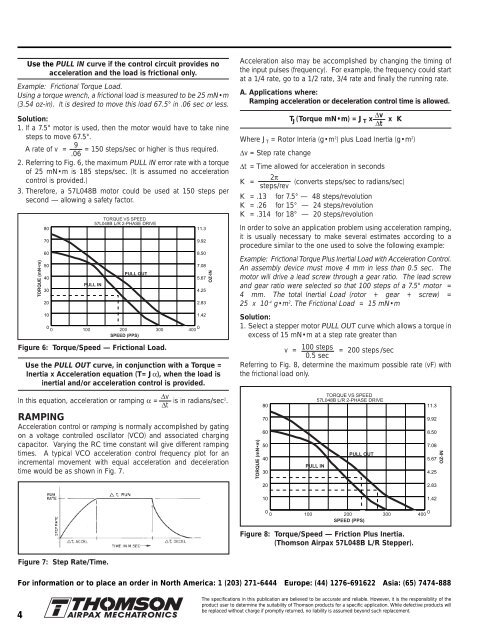Stepper Motor Technology
You also want an ePaper? Increase the reach of your titles
YUMPU automatically turns print PDFs into web optimized ePapers that Google loves.
Use the PULL IN curve if the control circuit provides no<br />
acceleration and the load is frictional only.<br />
Example: Frictional Torque Load.<br />
Using a torque wrench, a frictional load is measured to be 25 mN•m<br />
(3.54 oz-in). It is desired to move this load 67.5° in .06 sec or less.<br />
Solution:<br />
1. If a 7.5° motor is used, then the motor would have to take nine<br />
steps to move 67.5°.<br />
9<br />
A rate of v = = 150 steps/sec or higher is thus required.<br />
.06<br />
2. Referring to Fig. 6, the maximum PULL IN error rate with a torque<br />
of 25 mN•m is 185 steps/sec. (It is assumed no acceleration<br />
control is provided.)<br />
3. Therefore, a 57L048B motor could be used at 150 steps per<br />
second — allowing a safety factor.<br />
TORQUE (mN•m)<br />
80<br />
70<br />
60<br />
50<br />
40<br />
30<br />
20<br />
10<br />
TORQUE VS SPEED<br />
57L048B L/R 2-PHASE DRIVE<br />
PULL IN<br />
PULL OUT<br />
0<br />
0 100 200 300 400<br />
0<br />
SPEED (PPS)<br />
Figure 6: Torque/Speed — Frictional Load.<br />
Use the PULL OUT curve, in conjunction with a Torque =<br />
Inertia x Acceleration equation (T= Jα), when the load is<br />
inertial and/or acceleration control is provided.<br />
∆v<br />
In this equation, acceleration or ramping α = is in radians/sec 2 .<br />
∆t<br />
RAMPING<br />
Acceleration control or ramping is normally accomplished by gating<br />
on a voltage controlled oscillator (VCO) and associated charging<br />
capacitor. Varying the RC time constant will give different ramping<br />
times. A typical VCO acceleration control frequency plot for an<br />
incremental movement with equal acceleration and deceleration<br />
time would be as shown in Fig. 7.<br />
11.3<br />
9.92<br />
8.50<br />
7.08<br />
5.67<br />
4.25<br />
2.83<br />
1.42<br />
OZ-IN<br />
Acceleration also may be accomplished by changing the timing of<br />
the input pulses (frequency). For example, the frequency could start<br />
at a 1/4 rate, go to a 1/2 rate, 3/4 rate and finally the running rate.<br />
A. Applications where:<br />
Ramping acceleration or deceleration control time is allowed.<br />
T J (Torque mN•m) = J T x<br />
x K<br />
Where J T = Rotor Interia (g•m 2 ) plus Load Inertia (g•m 2 )<br />
∆v = Step rate change<br />
∆t = Time allowed for acceleration in seconds<br />
2π<br />
K =<br />
(converts steps/sec to radians/sec)<br />
steps/rev<br />
K = .13 for 7.5° — 48 steps/revolution<br />
K = .26 for 15° — 24 steps/revolution<br />
K = .314 for 18° — 20 steps/revolution<br />
In order to solve an application problem using acceleration ramping,<br />
it is usually necessary to make several estimates according to a<br />
procedure similar to the one used to solve the following example:<br />
Example: Frictional Torque Plus Inertial Load with Acceleration Control.<br />
An assembly device must move 4 mm in less than 0.5 sec. The<br />
motor will drive a lead screw through a gear ratio. The lead screw<br />
and gear ratio were selected so that 100 steps of a 7.5° motor =<br />
4 mm. The total Inertial Load (rotor + gear + screw) =<br />
25 x 10 -4 g•m 2 . The Frictional Load = 15 mN•m<br />
Solution:<br />
1. Select a stepper motor PULL OUT curve which allows a torque in<br />
excess of 15 mN•m at a step rate greater than<br />
v =<br />
100 steps<br />
= 200 steps /sec<br />
0.5 sec<br />
Referring to Fig. 8, determine the maximum possible rate (vF) with<br />
the frictional load only.<br />
TORQUE (mN•m)<br />
80<br />
70<br />
60<br />
50<br />
40<br />
30<br />
PULL IN<br />
∆v<br />
∆t<br />
TORQUE VS SPEED<br />
57L048B L/R 2-PHASE DRIVE<br />
PULL OUT<br />
11.3<br />
9.92<br />
8.50<br />
7.08<br />
5.67<br />
4.25<br />
OZ-IN<br />
20<br />
10<br />
2.83<br />
1.42<br />
0<br />
0 100 200 300 400<br />
0<br />
SPEED (PPS)<br />
Figure 8: Torque/Speed — Friction Plus Inertia.<br />
(Thomson Airpax 57L048B L/R <strong>Stepper</strong>).<br />
Figure 7: Step Rate/Time.<br />
For information or to place an order in North America: 1 (203) 271-6444 Europe: (44) 1276-691622 Asia: (65) 7474-888<br />
4<br />
The specifications in this publication are believed to be accurate and reliable. However, it is the responsibility of the<br />
product user to determine the suitability of Thomson products for a specific application. While defective products will<br />
be replaced without charge if promptly returned, no liability is assumed beyond such replacement.



